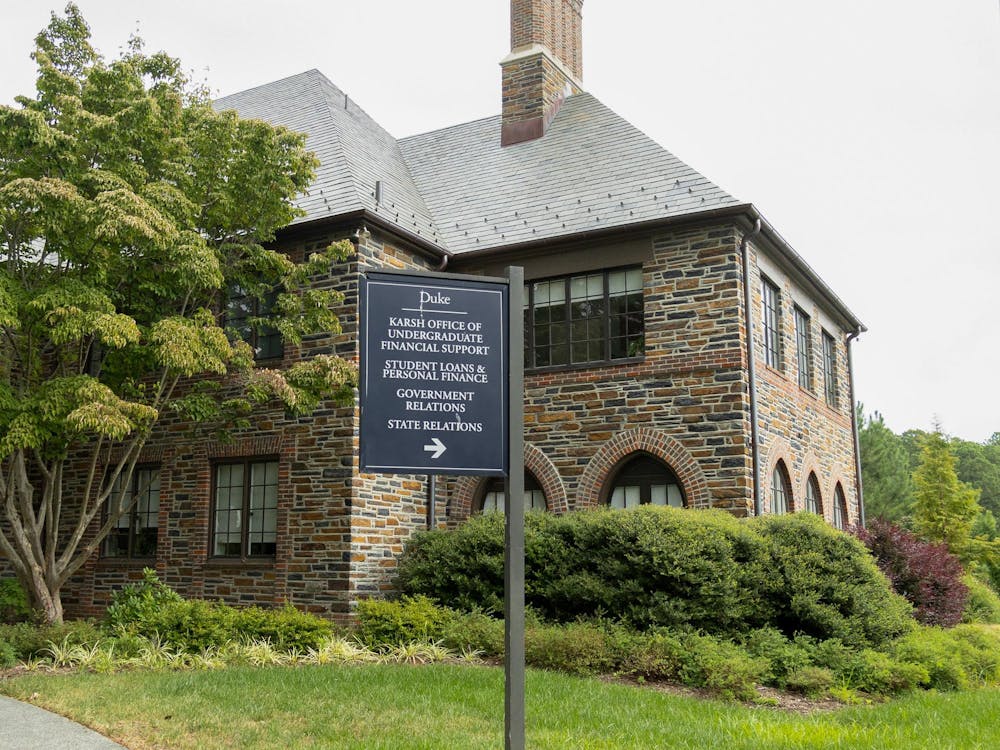Roughly 51% of Duke’s students receive some amount of financial aid, helping them afford the $88,938 price tag — an amount that has only increased over the years. But how does Duke provide financial aid, and where does that money come from?
Duke issues over $149 million in grant and scholarship aid every year. The money supports the University’s pledge to meet 100% of demonstrated financial aid through loans, grants and work-study programs — allowing 70% of students to graduate debt-free.
Grants are provided by Duke, the federal government or the state based on a student’s demonstrated financial need and are known as “gift-aid,” meaning that it does not need to be paid back. Institutional grants are funded mostly through the University’s endowments or donors. In a 2023 gift marking the University’s Centennial, the Duke Endowment donated $100 million “to broaden access to [a] Duke education.”
The Karsh Office of Undergraduate Financial Support calculates student need — the maximum amount of financial aid a student is eligible for — by subtracting a family’s expected contribution from the cost of attendance. Students seeking financial aid are required to complete the Free Application for Federal Student Aid and College Scholarship Service Profile every year.
One of the greatest changes Duke’s robust financial program has seen in recent years is the Initiative for the Students from the Carolinas, which “increased [Duke’s] support to low- and middle-income students locally.” Beginning in the 2023-24 academic year, the University pledged to provide Carolinian students with total household income below $150,000 full tuition grants, and those below $65,000 with assistance with room and board, meals, some course materials and other campus expenses, as well as the full cost of tuition.
A September 2023 article in the New York Times Magazine described Duke as falling behind its peer institutions in socioeconomic diversity, including in its portion of Pell-Grant eligible students. The article elicited a response from President Vincent Price, who suggested that it portrayed Duke’s socioeconomic diversity “in a rather harsh light.” Over the past two years, the amount of Pell-Grant eligible students has increased twofold to 22% of the Class of 2028 from 11% in the Class of 2026.
“Duke is actively engaged in increasing socioeconomic diversity, and in recent years we’ve increased our outreach efforts and information provided to admitted students,” wrote Miranda McCall, associate vice provost and director of the Karsh Office of Undergraduate Financial Support in an email to The Chronicle. “Support raised by Alumni Engagement and Development has been key to sustaining the aid program and its growth over the years.”
The vast majority of loans have a 10-year repayment period, in which students are responsible for paying back the cost of tuition expenses. These loans can be secured from the federal government, state government and agencies or private lenders. The most common student loan options provided by the University are direct subsidized loans and direct unsubsidized loans, the latter which accrue interest as soon as it is borrowed. The former begins accruing interest once the borrower graduates.
Each has a borrowing limit that cannot exceed the cost of attendance, while many loans also have an annual or lifetime limit. The cost of borrowing, although varied on a case-by-case level, includes an origination fee from the lender, interest rates on the loan and interest accrual if a loan has not yet been paid.
Work-study is awarded through the FAFSA and allows current students to work up to 19.9 hours a week and receive $2,200 annually. Primarily on Duke’s campus, these part-time jobs can relieve outstanding tuition burden, as a portion of a student’s wages are paid for by financial aid.
Financial aid also applies to Duke-In and Duke-approved study-away programs, though work study is replaced with grant funding when a student travels through the Global Education Office.
Duke applicants are automatically considered for merit-based scholarships during the college application process, except for the Robertson Scholarship. However, the Karsh Office only makes need-based aid offers, so merit scholars are selected separately by the Office of University Scholars and Fellows.
Get The Chronicle straight to your inbox
Sign up for our weekly newsletter. Cancel at any time.
Addison Smith is a Trinity first-year and a staff reporter for the news department.

